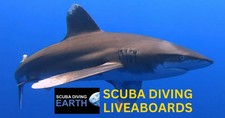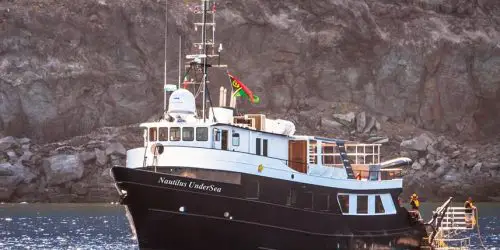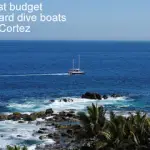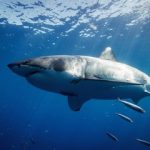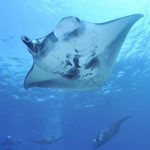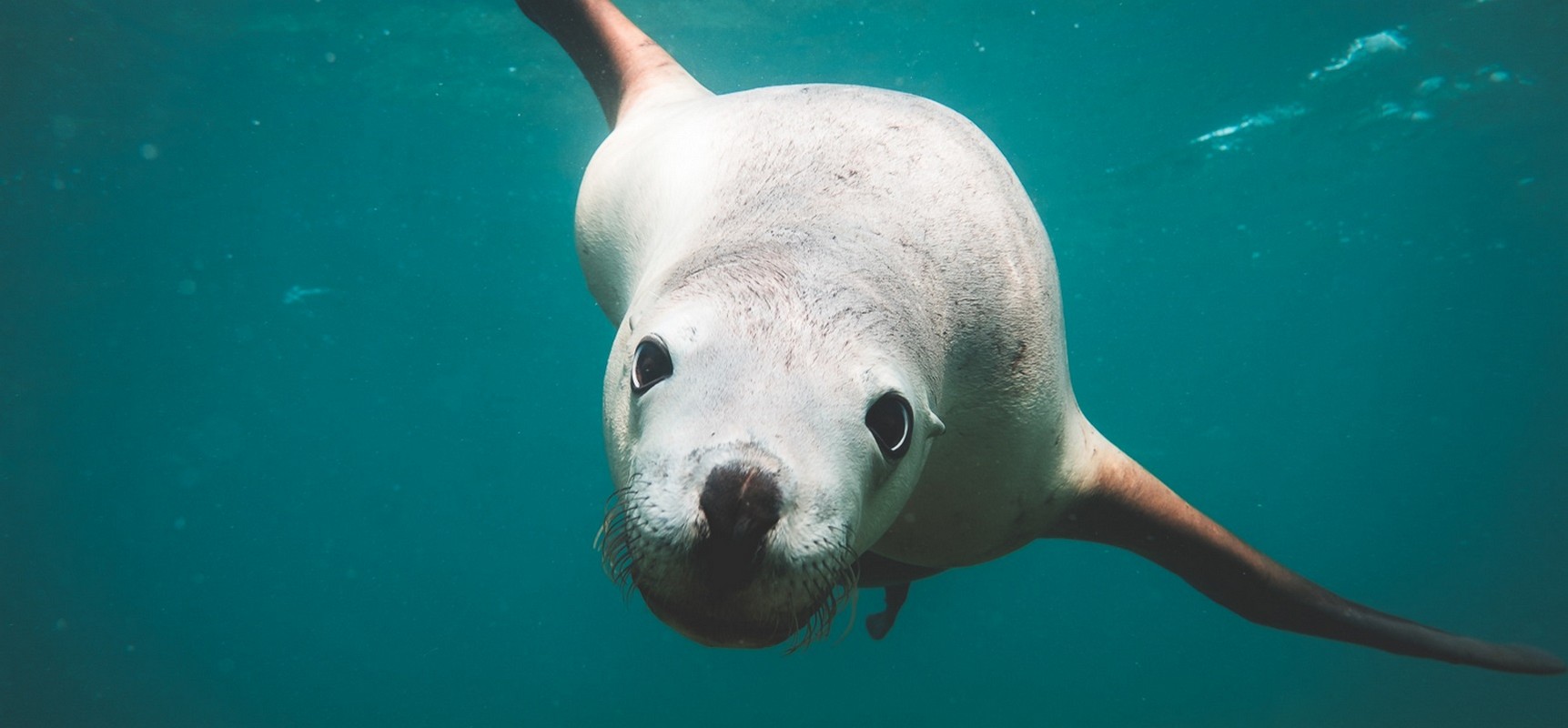
Sea Of Cortez Liveaboard Diving
Liveaboard Diving A World Heritage Site With Mobula Rays, Schooling Hammerheads, Whale Sharks, Mantas, Whales And Dolphins
Popular Sea of Cortez Liveaboards
|
MV Nautilus Belle Amie; Liveaboard diving in Mexico; 9.4 out of 10 and ; from £241, $315, €294/day. Customer Review: ”A truly memorable experience with friendly staff, excellent food and the most amazing diving. We picked this trip as we had never seen an oceanic manta, they did not disappoint. In addition we saw dolphins up close underwater and numerous species of shark not seen before plus, on one dive, several amazing encounters with a whale shark. The organisation by the crew to ensure we had the best experience whilst on the boat was truly exceptional, nothing seemed too much trouble. Although the diving was intense, when out of the water we were able to relax and felt cared for by all the staff. Such a good trip with great memories to look back on, until the next time…” Recommended for: The people, crew and divers. The boat, comfortable and relaxing. The diving, incredible! |
|
MV Valentina; Liveaboard diving in Mexico; 9.2 out of 10 and is rated 'Superb'; from £297, $400, €374/day. Customer Review: ”Unique and Unforgettable!! The whole trip was well organised from the initial meeting at San Jose airport to the drop off at the end. Lorenzo (Mexican) is the main guide, and a true gentleman. He is as caring as your own father! Full of enthusiasm for each dive site and seems to have the manta’s and dolphins on speed dial! We also saw schools of hammerheads and my first tiger shark in 18 years of diving. The other guide was a young Japanese lad called, Rui. Again, he was full of life and knew the dive sites very well, and couldn’t wait to get back in the water for the next dive. This is the enthusiasm that you want on a dive trip. I have been on the odd boat where the guides are tired and can’t be bothered to dive. I don’t mind having a small cabin that doesn’t have the latest flat screen TV, or missing out on warm fluffy towels on the dive deck. The guides and the crew make ALL the difference on these trips. Both of these guides help make the trip very special with the wildlife encounters which we all had. The whole crew are a credit and know exactly what they are doing. The food was the best that I have ever had on 20+ liveaboards inc The Odyssey in Truk lagoon. The Valentina was a much better trip. The cabins are quite old, but the boat is clean, hygienic and run so well. Yes there’s quite a bit of sailing to get there, but all the great dive sites around the world entail the same. If they were too easy to get to, they would be over dived and ruined. I can’t wait to book again to try and see the humpback whales on the next trip!” Recommended for: 1) Dolphins, mantas and sharks that are tame and used to seeing divers. These are wild and yet they hang around and play in your bubbles! 2)The guides are fantastic.Really keen, but safe and good fun. 3)All the crew were great – attentive but not over the top. |
|
MV Rocio del Mar; Liveaboard diving in Mexico; 9.3 out of 10 and is rated 'Superb'; from £291, $290, €271/day. Customer Review: ”Sea Lions and Whale Sharks. Best parts were diving and interacting with the sea lions. We also had a long snorkel with the Whale Sharks which was quite memorable. The crew was fantastic and food was very good too. In addition black coral forests were fantastic along with nudibranchs and other sea life. Overall an excellent trip.” Recommended for: Diving, Sea Lions, Whale Sharks, Food on boat. |
|
MV Quino el Guardian; Liveaboard diving in Mexico; 8.8 out of 10 and is rated 'Fabulous'; from £235, $289, €270/day. Customer Review: ”An amazing trip with 20 dives in super Viz and so much to see.. The highlights were closely interacting with the Giant Manta’s, And visiting local areas and dive sights in Baja before the sailing, esp. Cabo Pulmo.” Recommended for: The Pelagics were fabulous …The crew were brilliant…and the food was really great. |
|
MV Nautilus Under Sea; Liveaboard diving in Mexico; 8.8 out of 10 and is rated 'Fabulous'; from £241, $315, €294/day. Customer Review: ”Fantastic viewing of Great Whites and a super enjoyable trip. Seeing Lucy a big female turn up for last few hours of trip.” Recommended for: Sharks, food and visibility. |
|
MV Nautilus Gallant Lady; Liveaboard diving in Mexico; 9.4 out of 10 and is rated 'Superb'; from £251, $381, €356/day. Customer Review: ”A week of highlights. I experienced several firsts- bull sharks, eagle rays, mobula rays, and sea lions that interacted all day! The boat was very comfortable and the staff went above and beyond to guarantee a memorable week.” Recommended for: Sea life, staff, food. |
TO SEE ALL SEA OF CORTEZ LIVEABOARDS SCROLL TO THE TABLE BELOW
Liveaboard Diving in Sea Of Cortez
Sea of Cortez liveaboard diving is about a diver’s paradise World heritage site with sea lions, 100’s of mobula rays, whale sharks, schooling hammerheads, mantas, whales, dolphins and huge fish schools in a narrow stretch of sea between mainland Mexico and Baja California Peninsula down to La Paz.
Scuba diving in the Sea of Cortez and La Paz is all about California sea lions, whale sharks, hammerhead sharks, tuna, manta rays, mobula rays, dolphins, whales and huge schools of fish like the blue stripped snapper, surgeonfish, plus enjoying captivating underwater macro life.
Legendary diver Jacques Cousteau described the Sea of Cortez as the “world’s aquarium“, which speaks for itself. The Sea of Cortez is also the easiest “big animal” destination for divers from the United States to access from airports such as San Diego and Los Angeles.
The Sea of Cortez is sheltered from the Pacific Ocean by the Baja California Peninsula, which connects to California’s southern tip near San Diego. The Sea of Cortez (also known as the Gulf of California) is 1,200 kilometres (750 miles) long, and stretches from Cabo San Lucas on the southern tip of the peninsula to Isla Montague in the far north of the sea.
There are various locations along the Baja California Peninsula to stay in a resort and dive by day boat, but a Sea of Cortez liveaboard cruise gives you the opportunity to reach more dive sites, dive more times per day, whilst having the opportunity to see whales breaching and dolphins or orcas surfing alongside the boat whilst transiting between locations.
Where is The Best Diving Sea of Cortez
The best diving in the Sea of Cortez includes the following 9 diving locations:
- Isla San Pedro Martir is all about the sea lions. Isla San Pedro Martir is a tiny island in the middle of the Sea of Cortez that is surrounded by deep upwellings of nutrient-rich waters that produce an abundance of life. A great spot for diving with curious and friendly sea lions,. If you can’t see the sea lions, look behind you as they may be playing with your regulator hoses or tugging at your fins (see video below). When diving Isla San Pedro Martir you may also see turtles, large schools of fish, and the resident sperm whales that live here. The Nautilus Belle Amie liveaboard has a spotter plane to direct the boat to the sperm whales, plus fin-back whales, orcas or other big animals nearby.
- Bahia de Los Angeles is all about whale sharks and is in the north of the Sea of Cortez. There are sometimes more than 200 whale sharks at Bahia de Los Angeles at certain times of the year. This is another dive site visited by the Nautilus Belle Amie liveaboard.
- Suwanee Reef is close to La Paz and can be dived by day boats and liveaboards alike. Liveaboards dive Suwanee Reef enroute to other dive sites in the Sea of Cortez. This reef is teaming with life, including large shoals of reef fish and snappers, moral eels, puffer fish, parrotfish, triggerfish, turtles, plus there is also a wreck dive too.
- Las Animas diving is where you can snorkel with whale sharks, plenty of sea lions and fin-back whales.
- Los Islotes dive site is all about the sea lions, as there is one of the largest sea lion colonies in the Sea of Cortez for divers to enjoy.
- El Bajo is all about the schooling hammerhead sharks. El Bajo is the best dive site for swimming with large schools of hammerheads in the Sea of Cortez (see video below).
- La Reina dive site is located on the north tip of Isla Ceralvo, and if you’re in luck you will see manta rays at this dive site. La Reina is also known for the huge shoals and bait balls of snapper in their hundreds, plus you will see sea lions, moray eels and plenty of other reef fish.
- Loreto bay and islands is a great place for underwater photographers and diving with small critters like nudibranchs, octopus, moral eels and other small creatures. But the Loreto dive sites are not just about small creatures, as you will also see playful sea lions, large shoals of mobula rays, dolphins, whale sharks, barracudas, turtles, stingrays, spotted eagle rays, orcas and large shoals of snapper (see video below).
- Isla De Lobos is all about the sea lions at a site near to La Paz on the south of the Baja California Peninsula.
Isla San Pedro Martir
La Reina Diving Video
El Bajo Diving Video
Loreto Bay Diving Video
When Can You Dive in Sea of Cortez?
You can dive the Sea of Cortez from a liveaboard from July to October, depending on which Sea of Cortez liveaboard you choose. For example, liveaboard Nautilus Belle Amie offer whale shark diving trips between July-November, and Valentina Liveaboard run their Sea of Cortez Exploration trips between August-October.
The visibility in the Sea of Cortez is best between July-December, which can be up to 25 metres (82 feet).
If you want to dive in the more remote locations of the Sea of Cortez, a liveaboard is the best way to do so. Diving from a Sea of Cortez liveaboard offers you a better chance to see sea lions, whales, whale sharks, hammerheads, mobula rays and manta rays all on the same trip.
Can You Scuba Dive in The Sea of Cortez?
You can scuba dive the Sea of Cortez, and probably the best way to do so is to book a Sea of Cortez liveaboard, which will take you on a trip to the more remote locations and the best dive sites to see hammerheads, dolphins, mobula rays, manta rays, whale sharks, sea lions and whales.
An example video from a guest onboard the Nautilus Galant Lady liveaboard with highlights of sea lions, a humpback whale, fin-back whales, large shoal (in their thousands) of jumping mobula rays, hammerhead sharks and dolphins all seen on one Sea of Cortez liveaboard diving trip.
Northern Sea of Cortez Diving
Northern Sea of Cortez diving is best done by liveaboard trip, as you get to dive at various great dive spots enroute north. One diving spot in the northern Sea of Cortez that’s great to snorkel or dive with whale sharks is Bahia de Los Angeles between July and October.
What is The Sea of Cortez Famous For?
The Sea of Cortez is famous for diving with sea lions and was made famous by Jacques Cousteau when he named it the “Aquarium of the World”, which is also a protected UNESCO World Heritage Site.
“The site comprises 244 islands, islets and coastal areas that are located in the Gulf of California in north-eastern Mexico. The Sea of Cortez and its islands have been called a natural laboratory for the investigation of speciation. Moreover, almost all major oceanographic processes occurring in the planet’s oceans are present in the property, giving it extraordinary importance for study. The site is one of striking natural beauty in a dramatic setting formed by rugged islands with high cliffs and sandy beaches, which contrast with the brilliant reflection from the desert and the surrounding turquoise waters. It is home to 695 vascular plant species, more than in any marine and insular property on the World Heritage List. Equally exceptional is the number of fish species: 891, 90 of them endemic. The site, moreover, contains 39% of the world’s total number of species of marine mammals and a third of the world’s marine cetacean species.“
UNESCO
The Big-Five of The Sea of Cortez
The Big Five of the Sea of Cortez are sea lions, whale sharks, hammerhead sharks, mobula rays and whales.
- Sea lions at Los Islotes.
- Whale sharks at Bahia de Los Angeles.
- Hammerhead sharks at El Bajo.
- Mobula San Caba San Lucas and Loreto.
- Whales in the whole of the Sea of Cortez.
Table of Sea of Cortez Liveaboards
This list of Sea of Cortez liveaboards is in descending customer rating order, so the liveaboards with the highest customer rating will be at the top of the list. To filter this table for the features that are important for your Sea of Cortez liveaboard trip, select from the list of filters below.
| Discover Liveaboard | Customer Reviews | Price Per Day | |
|---|---|---|---|
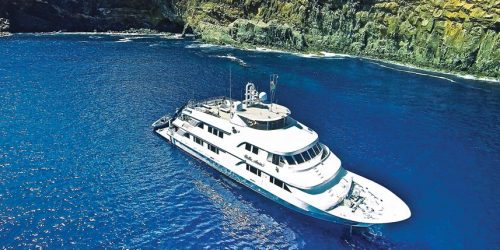 |
Review: MV Nautilus Belle Amie; Book: MV Nautilus Belle Amie | 9.4 Exceptional | from £241; $315; €294 |
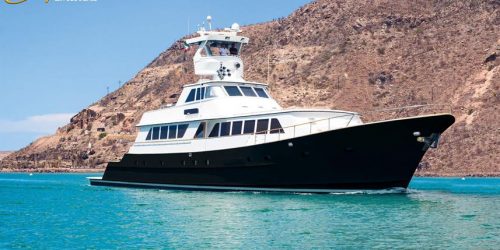 |
Review: MV Nautilus Gallant Lady; Book: MV Nautilus Gallant Lady | 9.4 Superb | from £251; $381; €356 |
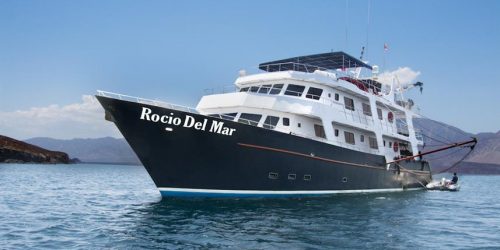 |
Review: MV Rocio del Mar; Book: MV Rocio del Mar | 9.3 Superb | from £291; $290; €271 |
 |
Review: MV Valentina; Book: MV Valentina | 9.2 Superb | from £297; $400; €374 |
 |
Review: MV Nautilus Explorer; Book: MV Nautilus Explorer | 8.9 Fabulous | from £259; $315; €294 |
 |
Review: MV Quino el Guardian; Book: MV Quino el Guardian | 8.8 Fabulous | from £235; $289; €270 |
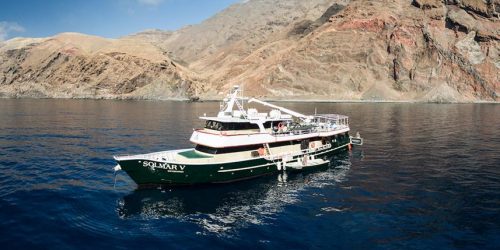 |
Review: MV Solmar V; Book: MV Solmar V | 8.7 Fabulous | from £286; $349; €326 |
- 1
- 2
Note: The above “Price Per Day” was correct at the time of producing this article, as was the exchange rate used to convert the GBP cost to US Dollars and Euros. For an up-to-date cost for your chosen liveaboard, please visit the “Book” link above.
Other questions answered about diving the Sea of Cortez:
Are There Sea Lions in The Sea of Cortez?
There are large colonies of Californian sea lions found in the Sea of Cortez, and in locations such as Isla San Pedro Martir, Los Islotes, Loreto bay and La Reina there are thriving populations of sea lions to enjoy diving with.
Be aware that sea lions are inquisitive, playful and mischievous, and they can bite. Be careful not to touch them, and let the sea lions come to you. Some of the juvenile sea lions (like the seals in the Farne Islands) will be more curious and playful than others and will interact with divers, play with their regulator hoses and tug on their fins, as per the following video in Los Islotes:
Are There Hammerhead Sharks in The Sea of Cortez?
There are hammerhead sharks in the Sea of Cortez, and there is almost certainty to see hammerhead sharks at dive sites like El Bajo, which is one of the dive stops on Sea of Cortez liveaboards, and in particular the Valentia liveaboard.
Where is The Best Dive Site to See Hammerheads Sea of Cortez?
One of the best dive sites to see hammerhead sharks in the Sea of Cortez is El Bajo, which is east of Los Islotes, and is a dive site visited on liveaboard itineraries by the Valentia liveaboard. At times there maybe many hundreds of hammerhead sharks schooling at El Bajo in the Sea of Cortez.
Is The Sea of Cortez Shark Infested?
The Sea of Cortez is not shark infested, but there are plenty of sharks and different shark species in the Sea of Cortez. Sharks found in the Sea of Cortez include hammerhead sharks, whale sharks, bull sharks and great white sharks too.
You might want to read this article about great white sharks in the Sea of Cortez: Are There Great White Sharks In The Sea of Cortez. This article includes a video of a very large great white shark in the Sea of Cortez.
Are There Whale Sharks in Sea of Cortez?
There are whale sharks in Sea of Cortez and these gentle giants are present in large numbers and feed on the plankton-rich waters around locations like Bahia de La Paz in the south and Bahia de Los Angeles in the north.
Whale sharks are the largest fish in the ocean and grow to on average 5.5-9.8 metres (18-32 feet), but the largest accurately recorded whale shark was 18.8 metres (61.7 feet) long in the north-western Indian Ocean.
Whale Shark Diving Sea of Cortez
The best whale shark diving in the Sea of Cortez is on liveaboard Nautilus Belle Amie at Bahia de Los Angeles between July and October where you can dive or snorkel with many whale sharks. Whale sharks congregate in huge numbers at Bahia de Los Angeles, where at times there are over 200 animals.
Is it Better To Snorkel or Dive With Whale Sharks?
It is often better to snorkel than dive with whale sharks, as snorkelling has its advantages over diving in certain situations, for example; encounters with whale sharks are often in very shallow water, snorkellers can normally move faster than divers, plus snorkelers are not limited by air supply.
Are There Whales in The Sea of Cortez?
There are whales in the Sea of Cortez, including humpback whales, sperm whales, killer whales (orcas), fin-back whales and their cousins dolphins.
When Can You See Mobula Rays in The Sea of Cortez?
The best time to see mobula rays in the Sea of Cortez is May/June to July/August or November-January. The Sea of Cortez is home to the largest and most spectacular mass migration of mobula rays. Mobula rays congregate to breed in their thousands close to the shore near Cabo San Lucas and Loreto Bay.
Where Can You See Mobula Ray Migration?
You can see the mobula ray migration in the Sea of Cortez in Cabo San Lucas on the southern tip of Baja California Peninsula or north in Loreto Bay on a Sea of Cortez liveaboard. Thousands of mobula rays form huge schools just outside of Cabo San Lucas Marina, known as “mobula rays cabo season“.
Do Orcas Swim in The Sea of Cortez?
Orcas do swim in the Sea of Cortez, but encounters with orcas in this region are very rare. Killer whales are predators and will feed on sea lions, which are commonly found in the Sea of Cortez and is possibly what attracts them in the first place.
Do Orcas Live in The Sea of Cortez?
Orcas do live in the Sea of Cortez, as they are occasionally spotted, and are known to surf behind boats and will approach vessels being the curious creatures they are. The orcas, or killer whales, that live in the Sea of Cortez will be Eastern Tropical Pacific Orcas.
The following video is evidence of orcas swimming and living in the Sea of Cortez, with an amazing interaction with a person on a boat.
I hope you enjoyed this page about Mexico’s Sea of Cortez Islands liveaboard diving
I’d love to hear from you. Tell us about your adventures of diving and snorkeling, in the comments below. Please also share your photos. Either from your underwater cameras or videos from your waterproof Gopro’s!
If this article hasn’t answered all of your questions. If you have more questions either about snorkeling or scuba diving (or specifically about Mexico’s Sea of Cortez Islands liveaboard diving liveaboard diving), please comment below with your questions.
There will also be many more articles about scuba diving (and snorkeling) for you to read and learn about these fabulous sports.
Select Another Liveaboard Location
| All Liveaboard Locations |
| Specific Liveaboard Locations |
